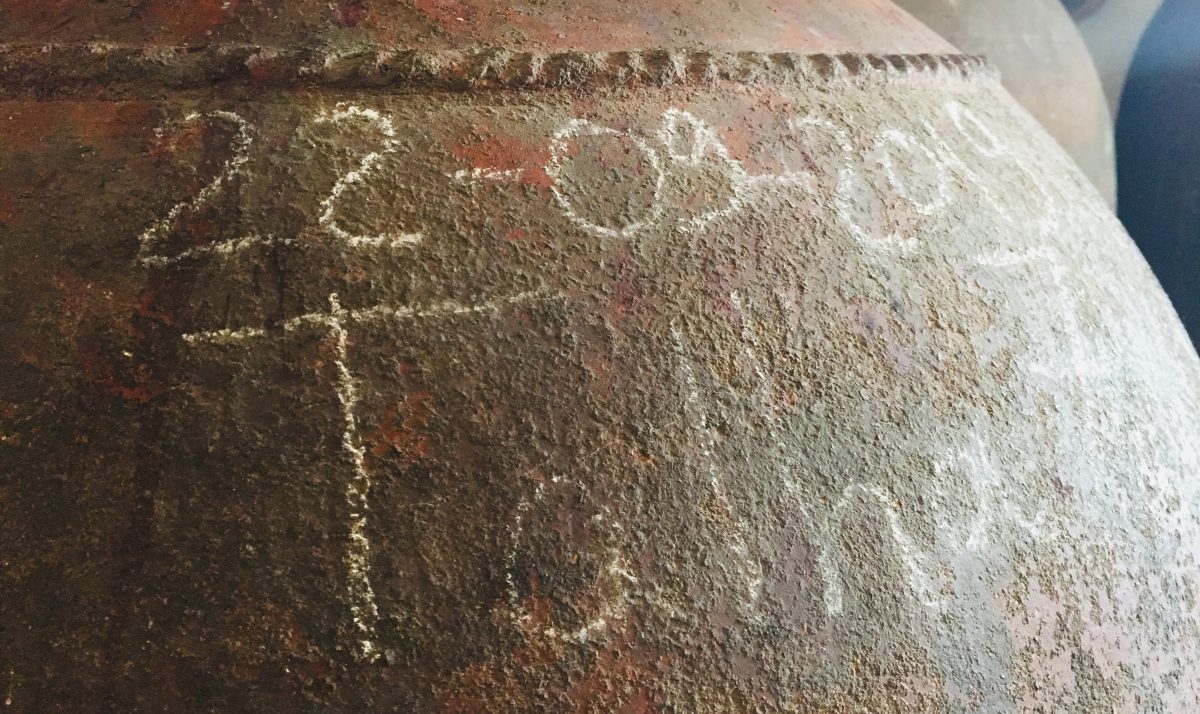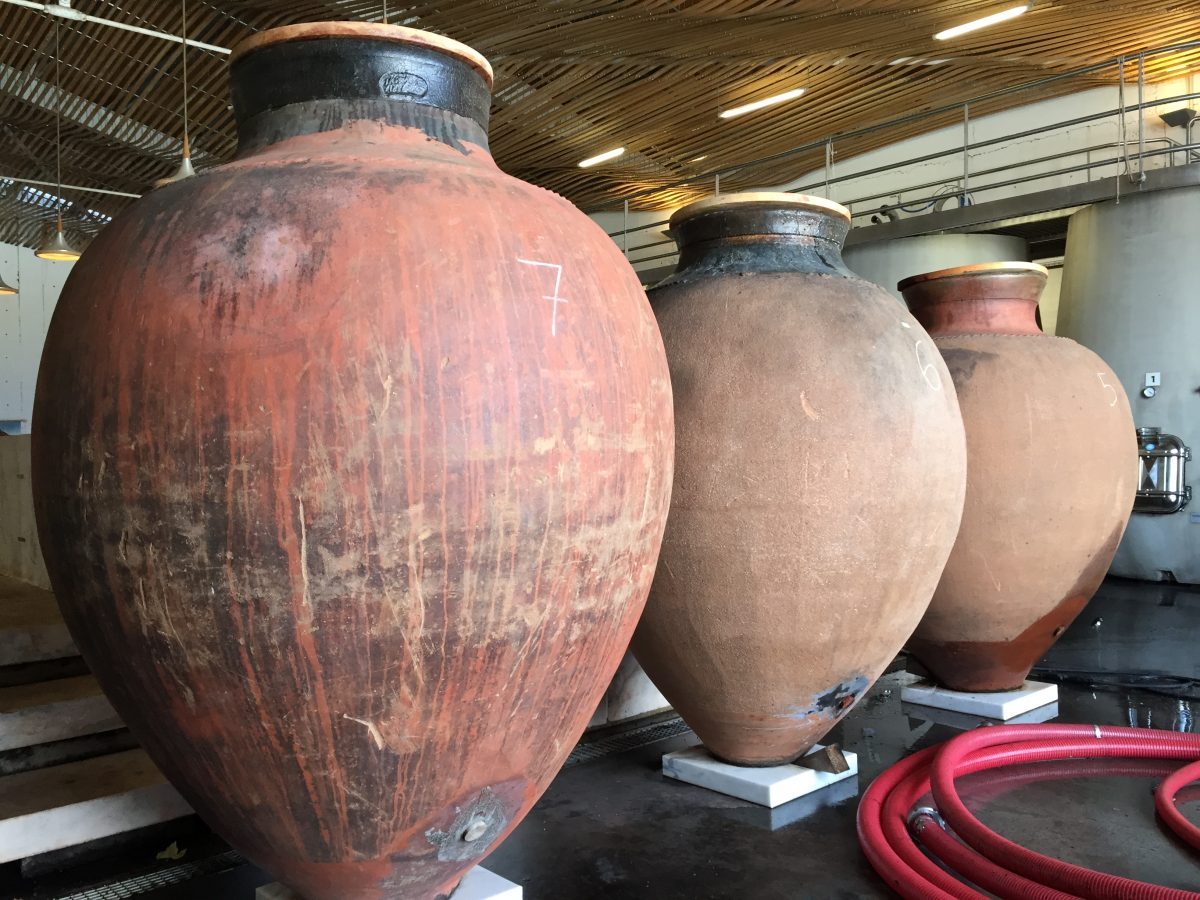Vinho de Talha: Portuguese Wine from Amphora
Reading Time: [est_time] Amphora wines are in fashion these days and are produced all over the world. While making wines in amphora (qvevri) may have originated in Georgia, the technique was revitalized by Joško Gravner (Collio,

Reading Time: 5 minutes
Amphora wines are in fashion these days and are produced all over the world. While making wines in amphora (qvevri) may have originated in Georgia, the technique was revitalized by Joško Gravner (Collio, Italy). But, it is Portugal that has the world’s only appellation dedicated to wines made in amphora.
In Alentejo, these vessels go by the name “talha”. It is derived from the Latin word “Tinalia” which refers to a large pot or vessel. In the past, talhas were used to store liquids like wine and olive oil. Today, the region is at the forefront of this new (yet ancient) style of Portuguese wine.

DOC Vinho de Talha
In 2012, the DOC “Vinho de Talha” was introduced. The law states that grapes can be grown in all eight subregions of Alentejo. To be certified as a Vinho de Talha, the wine must stay in the talha (amphora) from harvest until at least 11th of November. This is St. Martin’s day and marked the day when the Talhas were tapped traditionally to enjoy the wine throughout the year.
You can learn more about talha winemaking and the traditions in the short video below.
Portuguese wine from amphora in Alentejo dates back to Roman times, around 2000 years ago. Although the traditions have persisted in the region, it’s only recently that the wines have had a commercial renaissance. Many of the wineries, big and small, have added Vinho de Talha wines to their portfolio.

One distinctive difference in the amphora winemaking in Alentejo is the bunghole at the bottom of the vessel. Unlike qvevri in Georgia, the amphorae in Alentejo are not buried. They are kept above ground and the finished wine is drained out through a bunghole in the bottom, instead of being pumped out from the top of the vessel.

Youth is another major difference in Vinho de Talha wines versus many amphora wines made in other parts of the world. All of the wines I tasted were from the previous harvest and were not aged in anything other than talha and bottle. The reds and the whites all have chewy tannins. It was also great to see that none of the wines were oxidized. In general, Of all the wines I tasted, the red “Vinho de Talhas” showed better than the whites.
There are no current producers of high-quality talhas in Portugal. It’s difficult for producers to hunt down amphorae in good condition. Limited vessels mean that the production of Vinho de Talha is small.
Professor Talha
To really understand the modern talha movement in Alentejo, you must see the “professor”.
Professor Arlindo Maria Ruivo was instrumental in the formation of the Vinho de Talha DOC. He has one of the largest collections of talhas in the region at around 50. Visiting his cellar in the small village of Vila de Frades was the highlight of my trip through the region. It’s a small cellar under the family home but brims with energy and romanticism (similar to Gravner’s cellar in Collio, Italy).

I couldn’t directly communicate with the professor but could see the genuineness in his eyes and hear the passion in his voice. Professor Arlindo learned the art of talha winemaking in the 1960s by his father-in-law who founded the Adega Vidigueira cooperative winery.

Professor Arlindo produces small batches of wine with his granddaughter Teresa. I got a sneak preview of the wines and can’t wait to taste the finished products, they will be bottled under the name Gerações da Talha. It’s only right that the godfather of the modern talha movement has his own brand on the market.
Wine Recommendations:
You can find out more about our scoring system on the WINE RATING page.
*The production of Vinho de Talha is limited, which means that many of these wines are only available at the wineries.
- Esporão, Vinho de Talha Roupeiro 2018
Made from the grape Roupeiro, which stays on the skins for three months. Interesting nose of sweet peach, green guava, caramel, and dried apricot. This is a fantastic amphora. Weighty on the palate with salty and mineral notes. This has a slight sherry note on the finish. Gritty texture and a long finish. Just a touch of grippy tannins. Score: 90/100
- Esporão, Vinho de Talha Moreto 2018
The Esporaão Vinho de Talha Moreto is lighter in color for a red with notes of cherry, farm mud, mocha, and white pepper. Medium-bodied and juicy on the palate, you cannot feel the 14% of alcohol. Really nervy acidity and grippy tannin. Savory texture and good length on the palate. Score: 91+/100

- José Maria Fonseca, José de Sousa Puro Talha (white) 2016
The José de Sousa Puro Talha White is an extreme wine, it’s a blend of Antão Vaz, Manteúdo, and Diagalves. Fermented in talhas and aged with a layer of olive oil on top to prevent oxidation, old school style. Low in alcohol at 12% abv. It spends four months with the skins. Old school in style with pumpkin, apricots, ginger. High acidity, this is a bit funky and almost tastes unfinished. Has a sherry-like finish. Very challenging and unique white wine. In between an orange wine and a sherry. Score: 90+/100

- José Maria Fonseca, José de Sousa Puro Talha (red) 2015
The José de Sousa Puro Talha red is made with Grand Noir, Trincadeira, and Aragonez aged for 16 months in Talha and covered with olive oil. This is lower in alcohol at 12.5% ABV with an attractive nose of forest berry, fall leaves, earth, and cherry. This almost smells like a Sangiovese. Medium-bodied and elegant, this has very high acidity. The firm tannins beg for food but they aren’t overly drying. Score: 91/100
- São Miguel, Art. Terra Amphora Branco 2018
Find or buy on Wine-Searcher.
The Art. Terra Amphora Branco is mostly Arinto with some Antão Vaz. The wine stayed on the skins for three months in Talha. There are flavors of lemon, white peach, and tangerine peel. It is fresher than a normal orange wine. There is a slight nuttiness on the finish, but overall it is crisp. Salty and low level of tannins. Score: 89/100
- São Miguel, Art. Terra Amphora Tinto 2017
Find or buy on Wine-Searcher.
The São Miguel Art. Terra Amphora red is a blend of Aragonez, Trincadeira, and Moreto. Notes of pine, blackberry, black plum, and pepper. This is medium-bodied and silky with firm tannins. This has bright acidity to keep the wine light. Unique, delicious, and well made with a long finish. Score: 91/100

- Herdade do Rocim, Amphora 2018
The Herdade do Rocim Amphora is a blend of Moreto, Trincadeira, Tinta Grossa, and Aragonez. Notes of sour cherry, green herbs, pepper, and burnt meat. This is wild and juicy with firm tannins. Distinctive and unique. Very delicious. Made in amphora with no temperature control and indigenous yeasts. Score: 90+/100

- Vidigueira, Vinho de Talha 2018
The Vidigueira Vinho de Talha is a blend of grapes from bush vines over 100 years old. Grapes are Antão Vaz, Larião, Diagalves, Manteúdo, Perrum and Siria on the skins for three months. Concentrated with apricot, white peach, lemon peel, and fall leaves. Full-bodied and rich with about 2.5 g/L of RS. Full and chewy, ripe tannins, and a long finish. Score: 92+/100

- Cartuxa, Vinho de Talha 2017
The Cartuxa Vinho de Talha is made from Alicante Bouschet kept in the talha for eight months. There is a dark core of fruit with black cherry, blackberry, mulberry, smoke, and earth. This is full-bodied with firm tannins. It has weight and texture. The tannins are a bit fierce now and it would be interesting to see where this goes with time. Score: 89/100

- Santiago na Ânfora do Rocim, Alvarinho 2018 – Vinho Verde
The Santiago na Ânfora do Rocim Alvarinho is a cooperation between Herdade de Rocim in Alentejo and Quinta de Santiago in Vinho Verde. It’s made from Alvarinho. The grapes stay on the skins for two months and are fermented only in amphora. There are notes of yeast, lemon, and lime. This is a fresh white wine with texture. The time on the skins give texture but no tannins. Lively acidity rushes through the palate, tastes like a Cru Muscadet with a long finish. Score: 92/100

You Might Also Enjoy:
Alentejo: Plush Red Portuguese Wine and More
Do you like our content?
If you like our articles and videos, we’d love for you to be a part of our community on Patreon. The support from Patreon helps keep the content coming and you access to behind the scenes content. It also gives us the chance to get to know you better. Check out the Exotic Wine Travel Patreon page by clicking the photo below.
Thanks to the Vinhos do Alentejo for providing the appointments and accommodation during my stay. Please note that the opinions expressed in this article are unsolicited and have not been paid for in any way by governmental bodies, enterprises, or individuals. We do not sell editorial content as that would destroy the legitimacy of our reviews and the trust between Exotic Wine Travel and its readers. On occasion, we extend the option of purchasing the wines we review or/and the products we spotlight. Some of these product links are set up through affiliate programs, which means Exotic Wine Travel gets referral credits if you choose to purchase these items via the links we provide.


